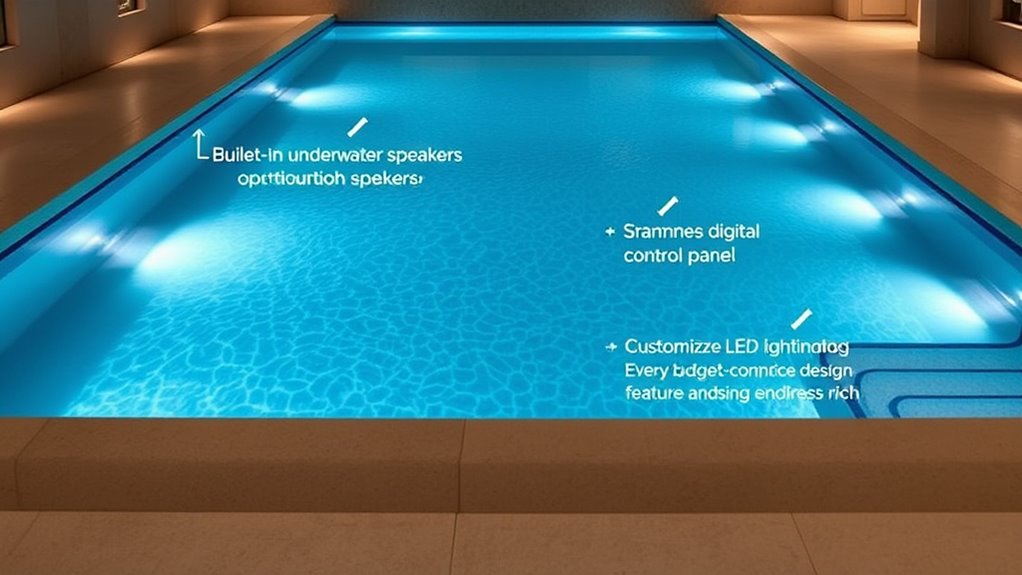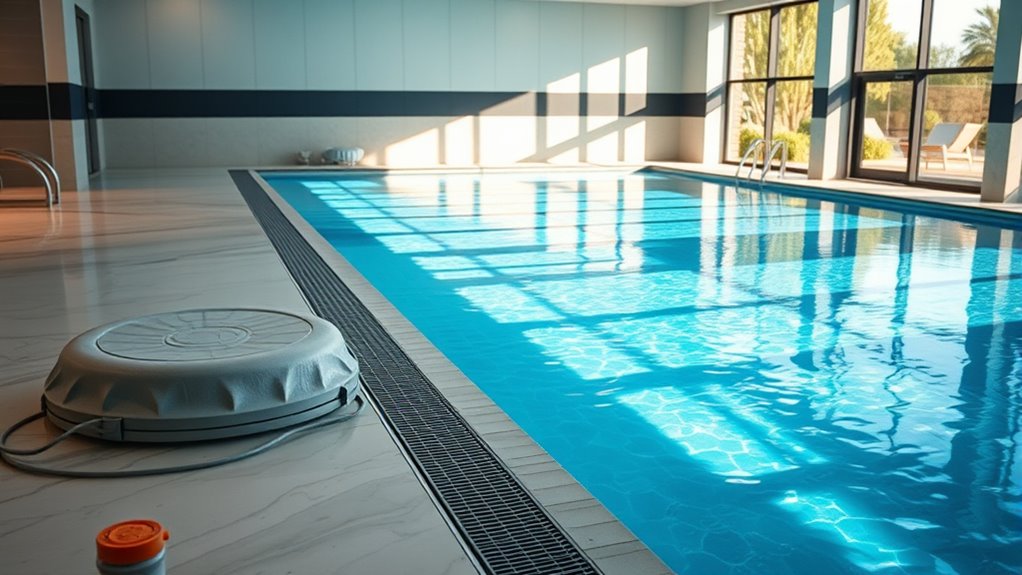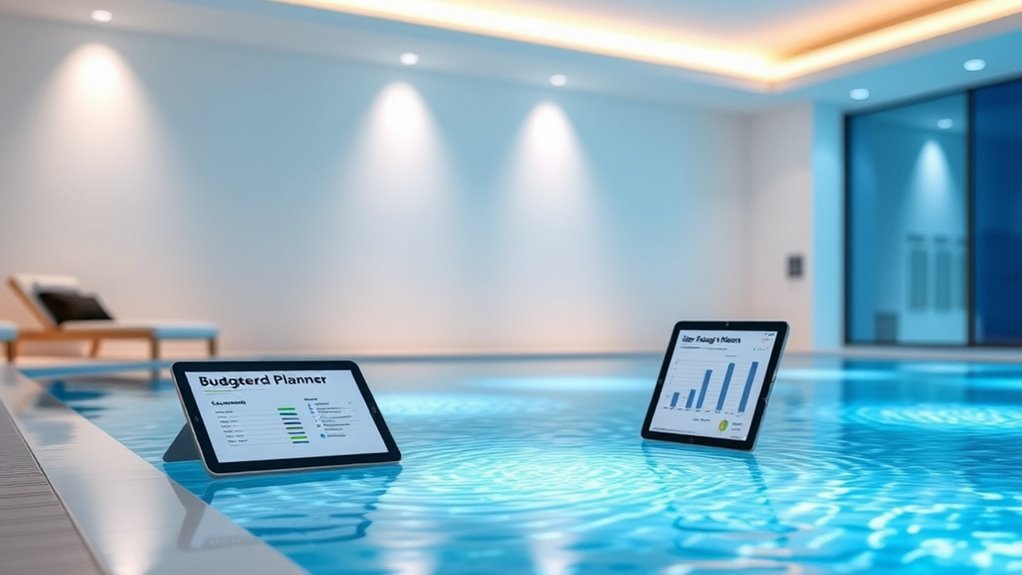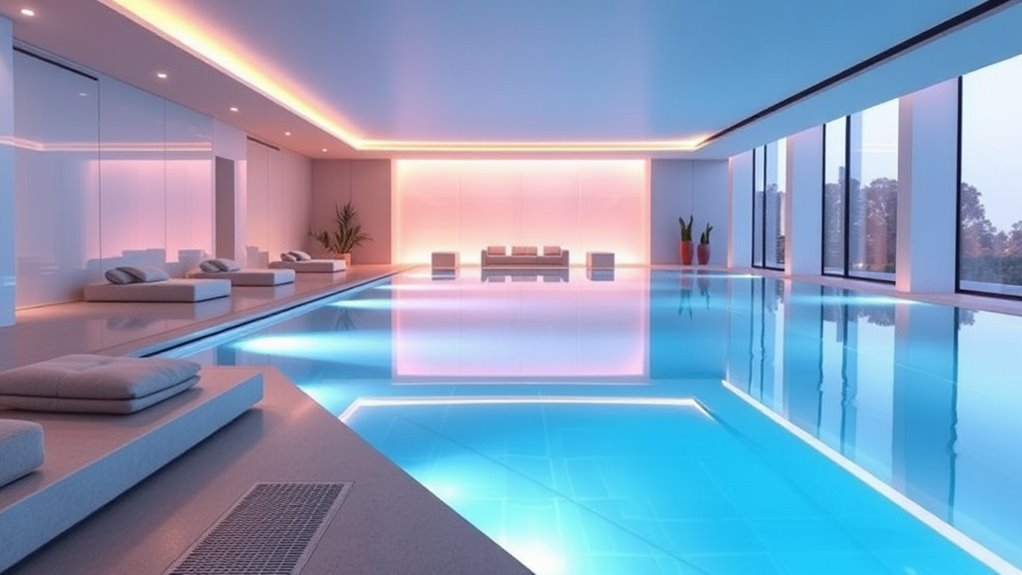In 2025, budgeting for an endless pool means more than just the upfront price. Hidden costs like site prep, permits, and unexpected structural issues can add thousands. You’ll also face ongoing expenses for energy, maintenance, and optional upgrades like lighting or covers. Don’t forget insurance and safety features, which protect your investment. Planning for surprises and future repairs is key. Stay tuned to discover essential tips that help you budget wisely for this luxurious feature.
Key Takeaways
- Hidden installation and site prep costs can significantly inflate the initial budget beyond the quoted price.
- Upgrading premium features and accessories considerably increases overall expenses.
- Energy consumption for heating, pumps, and filtration remains a major ongoing cost.
- Project delays and unforeseen structural issues can lead to unexpected financial overruns.
- Incorporating a contingency fund of 10-15% is essential to cover unpredictable expenses.
Hidden Installation Expenses and Site Prep

While the advertised price of an Endless Pool may seem affordable, many overlook the hidden installation expenses and site preparation costs that can considerably increase the total investment. You’ll likely need to clear and level the area where you plan to install the pool, which can involve excavation or ground reinforcement. If your space isn’t already suitable, you might require a concrete slab or reinforced decking, adding to expenses. Electrical work is another hidden cost, as you need a dedicated circuit and proper wiring to power the pool. Permits and inspections can also add fees. These unforeseen expenses can quickly add thousands of dollars, pushing your total cost well beyond the initial price tag. Proper planning helps you avoid surprises and ensures your pool installation goes smoothly. Regular site assessment and proper site preparation are essential steps to prevent unexpected costs during installation.
Energy Consumption and Operating Costs

Endless Pools are often marketed as cost-effective recreational options, but their energy consumption can substantially impact your long-term expenses. Running the heater, pump, and filtration system daily uses a significant amount of electricity, especially if you keep the water warm year-round. The cost varies depending on your local energy rates and how often you use the pool. Heaters can be the biggest expense, sometimes accounting for over half of the pool’s monthly operating costs. Additionally, poorly insulated units or outdoor installations may require more energy to maintain water temperature, increasing your bills. To manage costs, consider investing in energy-efficient equipment, using a pool cover, and setting ideal temperature levels. Being aware of these factors helps you budget more accurately for ongoing expenses. Incorporating energy-efficient technology can significantly reduce operational costs over time.
Regular Maintenance and Repair Expenses

Regular maintenance and repairs are essential to keep your Endless Pool running smoothly and prevent costly breakdowns. Regularly cleaning the filter and inspecting the pump can extend its lifespan and improve water quality. You should also check the water chemistry frequently to avoid corrosion or algae growth, which can damage equipment over time. Replacing worn-out parts like seals or filters right away helps prevent bigger, more expensive repairs later. Budget for annual inspections by a professional, especially as your pool ages. Keeping up with routine maintenance minimizes unexpected expenses and ensures your pool remains safe and enjoyable. While maintenance costs are generally manageable, neglecting them can lead to significant repair bills that strain your budget. Staying proactive saves you money and preserves your pool’s longevity.
Accessories and Optional Features

Adding accessories and optional features can enhance your Endless Pool experience, but they also come with additional costs. Upgrading with features like underwater lighting, advanced jets, or sound systems can substantially increase your overall budget. You might consider installing a cover lifter, which makes maintenance easier, or investing in a high-end filtration system for cleaner water. Personalized options such as custom steps, seating, or temperature controls add comfort but can raise expenses quickly. Keep in mind that some accessories require professional installation, adding to the total cost. While these upgrades improve usability and enjoyment, it’s essential to weigh their benefits against your budget. Prioritize features that will truly enhance your experience, and avoid overspending on non-essential extras. Consulting portable camping gear options can give you ideas for versatile, space-efficient add-ons that might suit your needs without breaking the bank.
Insurance and Safety Considerations

Investing in accessories and features can boost your pool’s comfort and functionality, but it’s also important to contemplate safety and insurance to protect your investment. You should review your homeowner’s insurance policy to ensure it covers potential damages or liabilities related to your pool. Installing safety features like fences, alarms, and covers reduces the risk of accidents, especially if children or pets are around. Regular maintenance and safety checks are critical to prevent issues like leaks or electrical hazards. Additionally, consider liability coverage that specifically addresses pool-related incidents. Being proactive about safety not only safeguards your loved ones but also helps you avoid costly claims or increased insurance premiums. Moreover, choosing security cameras designed for outdoor conditions can enhance monitoring and deter unauthorized access. Prioritizing these considerations guarantees your endless pool remains a safe and protected investment.
Long-Term Budget Planning and Resale Value

When planning for the long-term costs of an endless pool, you should consider future maintenance expenses that may add up over time. It’s also wise to stay aware of current resale market trends, which can influence how much your pool might be worth down the line. Being prepared for these factors helps guarantee your investment remains financially sound.
Future Maintenance Expenses
Planning for future maintenance expenses is essential to guarantee your endless pool remains in top condition and fits within your long-term budget. Regular upkeep prevents costly repairs and preserves your pool’s resale value. Expect routine tasks like filter replacements, chemical balancing, and cleaning to add up over time. Additionally, consider potential repairs for the pump, heater, or liner as they age. To help manage these costs, use the table below to estimate annual expenses:
| Maintenance Task | Estimated Cost / Year |
|---|---|
| Filter Replacement | $100 – $200 |
| Chemical Supplies | $150 – $250 |
| Equipment Repairs | $200 – $400 |
| General Cleaning | $50 – $100 |
Staying proactive guarantees your investment stays valuable and functional for years to come, especially as sound design techniques can be used to create audio cues for maintenance alerts or instructional guides.
Resale Market Trends
Understanding current resale market trends can help you make informed decisions about your endless pool’s long-term value. The resale market for pools is evolving, with increasing demand for eco-friendly and space-saving models. If your pool is well-maintained and includes popular features like energy-efficient systems or modern designs, you’ll likely see better resale value. Conversely, outdated or poorly maintained pools tend to depreciate faster. Location also plays a role; pools in high-demand areas retain value longer. Keep in mind that the overall housing market impacts resale prices, so downturns can reduce pool value regardless of its condition. Staying informed about trends helps you plan your investment wisely, ensuring your pool remains a valuable asset rather than a financial burden down the line. Paying attention to nutritional information and healthy maintenance practices can also enhance your pool’s longevity and appeal.
Unexpected Costs and Budget Overruns

Unexpected costs and budget overruns can quickly turn your endless pool project into a financial headache. You might encounter hidden expenses like permits, site preparation, or unforeseen structural issues that weren’t in the initial plan. Equipment upgrades or replacement parts can also add up unexpectedly, especially if you choose premium features. Labor costs may rise if delays occur or if contractors need extra time, pushing your budget beyond what you anticipated. Additionally, maintenance or future repairs might require extra funds down the line. To avoid surprises, always add a contingency fund—about 10-15% of your total budget—and stay flexible. Regularly review your costs and remain prepared for unexpected expenses to keep your project on track financially. Incorporating well-planned outdoor planters can also help optimize your space and reduce additional landscaping costs.
Frequently Asked Questions
Are There Any Hidden Fees Associated With Endless Pool Warranties?
Yes, there can be hidden fees with endless pool warranties. You might face charges for accidental damage, maintenance, or parts not covered under the standard warranty. Some warranties require you to pay for shipping or service calls, and extended warranties often come with additional costs. Always read the fine print carefully, ask your provider about potential extra fees, and consider these expenses when budgeting for your pool.
How Do Seasonal Changes Affect Ongoing Pool Operating Costs?
Oh, you didn’t realize that seasonal changes turn your endless pool into a money-draining monster? In winter, you’ll crank up the heater and lose more energy, skyrocketing your bills. Summer? You might spend extra on maintenance due to debris or algae. So, brace yourself—it’s like hosting a never-ending party where the costs keep rising with each season. Welcome to the wild world of year-round pool ownership!
What Are the Most Overlooked Safety Equipment Expenses?
You often forget to budget for safety equipment expenses like replacement filters, cover lifters, and chemical dispensers, which can add up quickly. Regular maintenance items such as safety covers, alarms, and first aid kits are essential but easily overlooked. Keep in mind that wear and tear means you’ll need to replace or upgrade these items periodically. Planning for these costs guarantees your pool remains safe and functional without unexpected expenses.
Can Customization Options Significantly Increase Total Lifetime Costs?
Customization options can markedly increase your total lifetime costs. While they may seem like a good idea upfront, each upgrade or personalized feature often comes with higher maintenance or replacement expenses down the line. You might save initially, but over time, these extras can add up substantially, impacting your budget. So, think carefully about which customizations truly add value and weigh them against potential long-term costs.
How Does Pool Usage Frequency Impact Long-Term Maintenance Expenses?
Higher pool usage means more frequent cleaning, filter changes, and chemical treatments, which can markedly raise your long-term maintenance costs. If you use your pool daily, you’ll need to budget for ongoing expenses like electricity and part replacements. Conversely, infrequent use reduces wear and tear, lowering costs. So, think about how often you’ll use the pool to better plan your maintenance budget and avoid surprises.
Conclusion
As you navigate the endless pool journey, remember that every dollar is a ripple shaping your future. Hidden costs are like unseen currents, quietly pulling at your budget’s edge. Stay vigilant, plan carefully, and don’t let surprises drown your dreams. By understanding these financial waves, you’ll ensure your investment flows smoothly—transforming your backyard oasis into a sanctuary that withstands the tides of time and expense.









